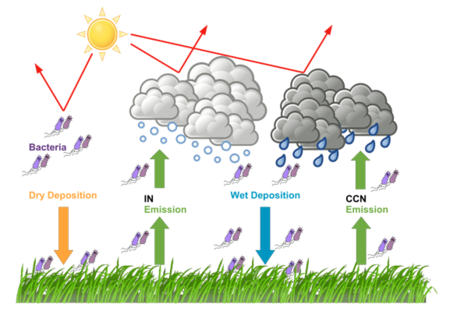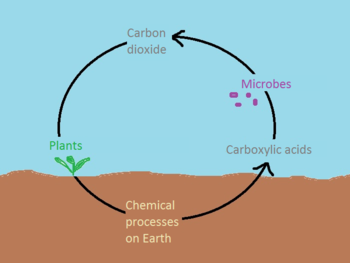Activity and Transport of Microbes in the Atmosphere
Introduction
Aeromicrobiology is the study of bioaerosols (biological aerosols) – microorganisms suspended in the air. Bacteria can be aerosolized into bioaerosols and subsequently transported to and deposited into different environments if they are able to grow at the sub-zero temperatures in the atmosphere during the transport phase [1]. These airborne bacteria, viable both in the atmosphere and on Earth, are important contributors to chemical processes in clouds and on Earth’s surface.

Presence of Bacteria in the Atmosphere
Bacteria have been found in natural atmospheric aerosols, precipitation, fog and cloud water and are a significant part of these environments, with viable bacterial cells amounting to approximately 20% of all particles in the range of 0.25-1μm diameter [2][3]. However, despite the efforts of several studies investigating the composition of bioaerosols, only a small proportion of airborne microorganisms near the Earth’s surface have been characterized in detail [3].
The low temperature, low pH, high UV exposure and oxidative environment of the atmosphere are harsh conditions that prevent the growth of many microorganisms and select for species with adaptations that allow them to survive [4]. For example, Grampositive bacteria tend to demonstrate greater resistance to UV damage and are present in higher proportions than Gram-negative bacteria during the summer months when there is more exposure to light [5]. High altitudes were also found to contain sources of nutrients capable of supporting bacterial growth [4]. Atmospheric samples have been noticed to consistently contain 17 bacterial taxa which share the ability to use various C1-C4 carbon compounds common in the atmosphere, suggesting that the presence of certain metabolic enzymes, shared among the taxa, allow them to utilize atmospheric nutrients [3].
Microbial Activity in the Atmosphere
Biotransformation of Atmospheric Organic Carbon Compounds
Bacteria are diverse in the range of substrates usable as nutrients, but only a few aerosolized microorganisms have been determined to be capable of transforming atmospheric compounds [6]. Mono- and dicarboxylic acids, one of the major classes of organic compounds found in the atmosphere, are common substrates for aerosolized microbes [7][8]. Some species can directly oxidize monocarboxylic acids such as formic acid into carbon dioxide, contributing about 24 million tons of CO2 annually [4][9]. Other species can transform low volatility dicarboxylic acids (products of fossil fuel combustion in internal combustion engines with impacts on global climate) into high volatility aromatic and heterocyclic compounds which can be recycled into the atmosphere [6][10].
Biotransformation of Atmospheric Organic Nitrogen Compounds
Dissolved organic nitrogen (DON) is a major component of cloud water and has increased with the growing use of fossil fuels and fertilizers [11]. Nitrifying bacteria in clouds are proposed to transform organic nitrogen into inorganic nitrogen by catalyzing the mineralization of DON to ammonia and the nitrification of DON to nitrate [11].
Ice Nucleation
Until recently, inorganic particles were believed to be the sole agent for initiating ice formation in the atmosphere, a critical process in precipitation [2]. Water may remain in the liquid state (supercooled water) at sub-zero temperatures and require freezing catalysts to allow the phase change to solid ice [12]. Many airborne microbial species are capable of being the nuclei for the formation of ice crystals and water droplets, thus influencing precipitation and cloud formation [3]. In particular, InaZ (ice nucleation activity protein Z) is an outer membrane protein that acts as an ice nucleus by allowing supercooled water molecules to cluster and form solid ice upon aggregating to a critical size [3][12]. InaZ is an important virulence factor in bacterial plant pathogens due to its effectiveness in damaging plant leaves to facilitate infection [3].

Transport in the Atmosphere
The atmosphere is recognized as an important player in the transport of microorganisms around the world. The exact bacterial species composition of communities in the atmosphere changes with cycles of aerosolization and deposition, and substantial changes in species composition have been observed after storms such as hurricanes which can add an entirely different set of bacteria into the atmosphere [3]. Once deposited onto the Earth’s surface, non-native microorganisms can greatly affect metabolic pathways and food webs in the area [1]. Sequencing of 16S rRNA of various strains of Pseudomonas syringae, an aerosolizable plant pathogen, revealed that the species was spread across many continents [13]. P. syringae is capable of infecting plants by producing toxins and acting as ice nuclei, thereby allowing it to survive and grow in any habitat with susceptible hosts (upon falling out in precipitation via its ice nucleating activity) [5][13].
Potential Health Hazards of Bioaerosols
Some sufficiently small bioaerosols (< 10 μm) can escape filtration by hairs in the nose and move deep into the lungs to cause severe diseases [14]. Open windrow composting facilities are an important source of potentially hazardous bioaerosols due to the agitation of composting material which contains bacteria and fungi capable of biodegradation [15]. Bioaerosols arising from composting facilities thus pose a great risk to workers and nearby residents due to the transport of microbes through the atmosphere [15].
Some microorganisms are pathogenic only when transmitted through the air; they are incapable of causing disease via person-to-person transmission [16]. Legionellosis and Korean hemorrhagic fever are examples of diseases caused by such airborne microorganisms [16].
References
(1) Sattler B, Puxbaum H, Psenner R. 2001. Bacterial growth in supercooled cloud droplets. Geophys. Res. Lett. 28:239. doi: 10.1029/2000GL011684.
(2) Bauer H, Giebl H, Hitzenberger R, Kasper-Giebl A, Reischl G, Zibuschka F, Puxbaum H. 2003. Airborne bacteria as cloud condensation nuclei. J. Geophys. Res. 108:4658. doi: 10.1029/2003JD003545.
(3) DeLeon-Rodriguez N, Konstantinidis KT, Lathem TL, Rodriguez-R LM, Barazesh JM, Anderson BE, Beyersdorf AJ, Ziemba LD, Bergin M, Nenes A. 2013. Microbiome of the upper troposphere: species composition and prevalence, effects of tropical storms, and atmospheric implications. Proc. Natl. Acad. Sci. U. S. A. 110:2575-2580. doi: 10.1073/pnas.1212089110.
(4) Amato P, Demeer F, Melaouhi A, Fontanella S, Martin-BiesseA, Sancelme M, Laj P, Delort A. 2007. A fate for organic acids, formaldehyde and methanol in cloud water: their biotransformation by micro-organisms. Atmos. Chem. Phys. 7:4159-4169. doi: 10.5194/acp-7-4159-2007.
(5) Amato P, Parazols M, Sancelme M, Laj P, Mailhot G, Delort A. 2007. Microorganisms isolated from the water phase of tropospheric clouds at the Puy de Dôme: major groups and growth abilities at low temperatures: Microorganisms from the water phase of tropospheric clouds. FEMS Microbiol. Ecol. 59:242-254. doi: 10.1111/j.1574-6941.2006.00199.x.
(6) Ho KF, Lee SC, Cao JJ, Kawamura K, Watanabe T, Cheng Y, Chow JC. 2006. Dicarboxylic acids, ketocarboxylic acids and dicarbonyls in the urban roadside area of Hong Kong. Atmos. Environ. 40:3030-3040. doi: 10.1016/j.atmosenv.2005.11.069.
(7) Fuzzi S, Facchini MC, Decesari S, Matta E, Mircea M. 2002. Soluble organic compounds in fog and cloud droplets: what have we learned over the past few years? Atmos. Res. 64:89-98. doi: 10.1016/S0169-8095(02)00082-0.
(8) Kawamura K, Kasukabe H, Barrie LA. 1996. Source and reaction pathways of dicarboxylic acids, ketoacids and dicarbonyls in arctic aerosols: One year of observations. Atmos. Environ. 30:1709-1722. doi: 10.1016/1352-2310(95)00395-9.
(9) BVaïtilingom M, Amato P, Sancelme M, Laj P, Leriche M, Delort A. 2010. Contribution of microbial activity to carbon chemistry in clouds. Appl. Environ. Microbiol. 76:23-29. doi: 10.1128/AEM.01127-09.
(10) Ariya PA, Nepotchatykh O, Ignatova O, Amyot M. 2002. Microbiological degradation of atmospheric organic compounds. Geophys. Res. Lett. 29:2077. doi: 10.1029/2002GL015637.
(11) Hill KA, Shepson PB, Galbavy ES, Anastasio C, Kourtev PS, Konopka A, Stirm BH. 2007. Processing of atmospheric nitrogen by clouds above a forest environment. J. Geophys. Res. 112:D11301. doi: 10.1029/2006JD008002.
(12) Morris CE, Georgakopoulos DG, Sands DC. 2004. Ice nucleation active bacteria and their potential role in precipitation. J. Phys. IV France. 121:87-103. doi: 10.1051/jp4:2004121004.
(13) Morris CE, Kinkel LL, Xiao K, Prior P, Sands DC. 2007. Surprising niche for the plant pathogen Pseudomonas syringae. Infect. Genet. Evol. 7:84-92. doi: 10.1016/j.meegid.2006.05.002.
(14) Taha MPM, Drew GH, Longhurst PJ, Smith R, Pollard SJT. 2006. Bioaerosol releases from compost facilities: Evaluating passive and active source terms at a green waste facility for improved risk assessments. Atmos. Environ. 40:1159-1169. doi: 10.1016/j.atmosenv.2005.11.010.
(15) Sykes P, Jones K, Wildsmith JD. 2007. Managing the potential public health risks from bioaerosol liberation at commercial composting sites in the UK: An analysis of the evidence base. Resources, Conservation & Recycling. 52:410-424. doi: 10.1016/j.resconrec.2007.05.005.
(16) Mojica B. 1998. Topic: Airborne pathogens. J. Urban. Health. 75:506-507. doi: 10.1007/BF0242769.


